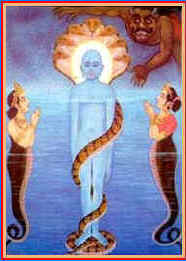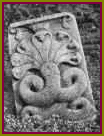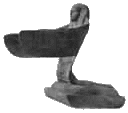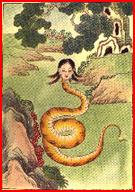 In Indian mythology, Nagas are primarily serpent-beings living under
the sea. Here we see the king and queen of water nagas worshipping
Parshva, the Jain
Tirthankara of the era before this one.
In Indian mythology, Nagas are primarily serpent-beings living under
the sea. Here we see the king and queen of water nagas worshipping
Parshva, the Jain
Tirthankara of the era before this one. The word Naga comes from the Sanskrit, and nag is still the word for snake, especially the cobra, in most of the languages of India. When we come upon the word in Buddhist writings, it is not always clear whether the term 'naga' refers to a cobra, an elephant (perhaps this usage derives from the snake-like trunk, or the pachyderm's association with the forest-dwellers of northeastern India who are also called Naga,) or a mysterious person of nobility. It is a term used for unseen beings associated with water and fluid energy, and also with persons having powerful animal-like qualities, or an impressive animal with human qualities.
In mythology, the category naga comprises all kinds of serpentine beings. Under this rubric are snakes, usually of the python kind, deities of the primal ocean and of mountain springs; also spirits of earth and the realm beneath it, and finally, dragons.
 In Indian mythology, Nagas are primarily serpent-beings living under
the sea. Here we see the king and queen of water nagas worshipping
Parshva, the Jain
Tirthankara of the era before this one.
In Indian mythology, Nagas are primarily serpent-beings living under
the sea. Here we see the king and queen of water nagas worshipping
Parshva, the Jain
Tirthankara of the era before this one.
All nagas are considered the offspring of the Rishi or sage, Kasyapa, the son of Marichi. Kashyapa is said to have had by his twelve wives, other diverse progeny including reptiles, birds, and all sorts of living beings. They are denizens of the netherworld city called Bhogavati. It is believed that ant-hills mark its entrance.
In Tibetan Buddhism, too, the naga is a water spirit.
Water symbolizes primordial Wisdom and in psycho-analysis, the storehouse that is the unconscious mind. However, to paraphrase Sigmund Freud commenting on the interpretation of symbols in dreams, "Sometimes a cigar is just a cigar." The water in naga lore is really wet.
In the language of Kashmir, the word for "a spring" is naga, and
nagas are considered the earliest inhabitants of that region. In a
sense this is borne out by geology since that valley was once "a vast span
of water, similar to a huge dam, walled in by high mountains. The
Nilamatapurana records how the valley was elevated out of water
and left under the care of the Nagas, of whom Nila, the son of Kashyapa,
was the chief." Kashmir is named after Kashyapa where
"the term ‘naga’ stands for spring; 'chesmah,' and 'negin' for small
spring. Springs are the main source of water in Kashmir." And
"the auspicious and famous river of Kashmir, the Vitasta (Jhelum)
originates from a spring near Verinag and is responsible for the
water supply to most parts of the valley. The religious significance
of the river is established by the Nilamata.purana [Myth of the Indigo
Goddess] when it records the entire land of Kashmir as the material
manifestation of Uma and describes her as the divine form of the
Vitasta."
"A large number of temples were built near springs and
were dedicated to the worship of nagas." and "These
places have become great centres of religious pilgrimage. The place names
of certain areas, e.g. Verinag, Anantnag and Seshanag even today remind
one of the intimate relations between the valley and the popularity of the
Naga cult. The Rajatarangini of Kalhana mentions Sushravas and Padma
Nagas, who were tutelary deities connected with the Wular lake. The
Dikpalas of Kashmir are believed to be four nagas, viz. Bindusara
in the east, Srimadaka in the south, Elapatra in the
west and Uttarmansa in the north."
Many Kashmiri festivals relate
to Naga worship, "for example during the first snowfall, Nila, the Lord of
Nagas, is worshipped. The Nagas are also propitiated in April and
are related to Iramanjari Puja and to Varuna Panchmi, which is organised
in July-August." And "in the darker half of the month of
Jyeshtha, when a big festival is organised to propitiate the king
Taksakyatra. The Nilamatapurana listed 527 Nagas that were
worshipped in Kashmir. In the account of Abul Fazal, the court historian
of Akbar, there are references to seven hundred places sacred to
serpents."
The purana also points to the association of the cult of
Nagas with that of Shiva. In the Mahabharata and
Harivamsa texts, Shesha was considered the son of Shiva. A
lesser relation was developed with regard to Vishnu as in his
sheshashayi form which links the primal waters with the sleeping
Vishnu. Also, Balarama who is Krishna's elder brother is the
personification of the snake, Ananta.
Kashmiri names such as Vishnasar and Krishnasar are Vaishnavite ones where the suffix sar means 'reservoir.' Even though Kashmir may be Muslim-dominated in contemporary times, a springs is "understood as naga and enjoys the respect of every religion."
"The prosperity goddess, Lakshmi, is said to have taken the form of the river Visoka (now known as the Vishov) to purify the people of Kashmir. Most probably, treating springs and rivers with great reverence wittingly or unwittingly resulted in the ecological balance necessary for a healthy and natural interaction between the environment and man."
" ... every naga has a snake as its guardian deity. Fishing is prohibited in these springs, though the fish which come out of the main garbha [den, lair] of a naga can be caught. Restrictions on fishing have definitely helped to some extent to preserve water ecology."
"Hindus still propitiate these nagas. At Martanda Naga even
srada is performed. Water is offered by Hindus to the Sun God and
to their ancestors (purvaj). Before having darshan of
the snow linga at
Amarnatha a holy dip is essential in the Seshanaga. A person
suffering from a skin disease is said to be cured after having a bath in
Gandhakanaga (sulphur spring) at Naghbal, Anantnag."
"Muslims show
their respect for these nagas in many ways. They offer sacrifices and
organise fairs on many festivals such as Id, [e]ven they do not catch fish
in these nagas. Their faith in nagas can further be established by an
example from Anantnag district, where during days of water scarcity or
extra rainfall, people offer sacrifices to the Vasuk[i] Naga (the water of
which remains in the valley during summer only and disappears in
winter.) They have full faith that offerings to Vasuk will bring
rain or stop it as desired."
~ B. Malla, Water Resources and Their Management in Kashmir
Vasuki [also Basuki,] the naga king, has the gem,
Nagamani, on his head. It is a universal panacea [cure-all] and is a
bestower of fortune.
Manasa Devi, the serpent
goddess, is Vasuki's sister. She is mostly identified with the
cobra, but she can cure any snakebite; indeed any adversity. A
popular Indian film shows Manasa coming to visit a man in his prison
cell. She drinks his offering of milk, then leaves, opening the cell
for him on her way out.
Now the maternal naga ancestor, Kadru, once enslaved Vinata, mother of birds. To ransom her, the Garuda stole amrita, the elixir of immortality, from the gods. Before the serpents could even have a taste, Indra stole it back again, however, a few drops of amrita fell to earth. The serpents slid through it which is why their skin now has the capacity of renewal.
The sharp grass upon which the nectar fell explains why serpents have forked tongues.
A contributor to the Bhakti email list (Ramanuja.Org) wrote:
Although, the snakes missed out on Amrita as intended, the forking of their tongues caused by Dharba might have provided them a blessing in disguise. Because according to modern science, the evolutionary success of advanced snakes might be due, in
part, to forked tongues. The forked tongue allows the snake to simultaneously sample two points along a chemical gradient, which is helpful in instantaneous assessment of trail location. Also may have role in mating.~ [Schwenk, Kurt. " Why snakes have forked tongues," Science vol. 263, 1994.]
 Nagas were
said to have raised their hoods to protect the Buddha, and other
jinas [spiritual victors] like the Jain saint Parshva.
Nagas were
said to have raised their hoods to protect the Buddha, and other
jinas [spiritual victors] like the Jain saint Parshva.
Because of its shape and its association with renewal, the serpent is a phallic symbol. This powerful emblem of fertility is thought to bring plentiful harvests and many children - images of nagas adorn houses and shrines and temples. It is said that when a king once banned snake worship, his kingdom suffered a drought, but the rains returned once the king himself placated Vasuki.
At least 1500 years before Buddha Shakyamuni's enlightenment when Ananta or Muchilinda with his many heads sheltered him, the mythic image of nagas doing homage to a great yogi was well-known.
 < imprint of a seal found at site of archaic Indus Valley
city
< imprint of a seal found at site of archaic Indus Valley
city
Nagarjuna, the champion of Buddhist philosophy of India is traditionally portrayed with a sunshade, or a halo of a multi-headed serpent. This 'Second Buddha' who established the Madhyamika school of philosophy [not materialist/not nihilist/not idealist,] the Indian mahasiddha Nagarjuna, received his illuminating insights and tantric empowerment with the help of the nagas in the lake beside which he meditated.
As there are serpents in Tibet, and nagas called Lu play a role in the symbolism of Tibetan Buddhism and in Tibetan mythology, so Nagarjuna is known as Lu-trub.
When the caravan finally got back, the monks told them that just before their return, an old man with attendants had visited Sera and presented a set of scriptures to the monastery. He said that he was delivering it for Sakya Yeshe. It was believed that the old man was really a Naga king, for when the texts were examined, it was found that they were still a bit damp.
Many examples of the naga association with Buddha appear on the walls and along an avenue leading to the temple of Ankhor Wat in Kampuchea [Cambodia] and also in Buddhist temples in Shri Lanka [Ceylon].
The traditional life-story [Tibetan: namthar] of Niguma, wife of Naropa, begins during the time of one of the earliest Buddhas in a region covered by water ruled by a great Naga King. This Naga was an accomplished and compassionate disciple of that Buddha and gave his permission for the miraculous drying up the water for the purpose of erecting a great temple and monastery. A bustling city grew up around these which acquired a certain reputation, and came to be called The Land of Great Magic. This is the place that Niguma was born.
Niguma developed the powerful tantric techniques referred to as the Five Dharmas of Niguma. The best known is called the Dream Yoga of Niguma. Her disciple, Naljor, is considered the head of the Shangpa Kagyu denomination of Tibetan Buddhism.
A bronze naga-king from Densatil monastery, Tibet, undergoing transformation.
Ulupi became Udupi in some Asian languages. Visit the land of the Nagas <-- we have our ways ... .
See a Thai
naga as conceived by S. Dhumphakdi & Sons Publisher,
Bangkok, Thailand (10 Perfections series.)
The winged naga links sky, earth and water.
 This is Uazet or Wadjet, the ancient
Egyptian form.
This is Uazet or Wadjet, the ancient
Egyptian form.
 The Creator-goddess of ancient China, Neu-kwa [Nu
Kua or Nu Gua], is here depicted like Echidna, of Greek
mythology, with only the head of a woman. However, she is usually
described as having the upper body of a woman that melts into her serpent
lower-half. After creation, during which she made humans, she put
down a rebellion against heavenly order. When the dying rebel chief
shook the heavenly pillars, she restored the sky by melting
turquoises.
The Creator-goddess of ancient China, Neu-kwa [Nu
Kua or Nu Gua], is here depicted like Echidna, of Greek
mythology, with only the head of a woman. However, she is usually
described as having the upper body of a woman that melts into her serpent
lower-half. After creation, during which she made humans, she put
down a rebellion against heavenly order. When the dying rebel chief
shook the heavenly pillars, she restored the sky by melting
turquoises.
Nu Huashi also used the toes of the cosmic tortoise (Kashyapa, of Indian mythology) as markers for the compass' directions. She restored the land at the time of the Flood with the ash from burnt reeds. Since she is credited with establishing the custom of marriage, she is considered the source of human order, too (like the Egyptian Ma'at.) The queen of all nagas, she combines and embodies creativity, cosmic order, water, earth and sky.
_______________________________________________________
Jain: Adherent of a religion whose teachings emphasize the absolute sanctity of all living things and asceticism in most aspects of life. The Buddha opposed its extreme nature.
darshan: viewing of an object or person that is considered to bestow a powerful blessing.
lingam: short pillar or phallic symbol standing for Shiva as creative Imagination. In the Himalayan cave at Amarnath, a special icicle is formed that is considered a manifestation of the deity.
[More about nagas] [About more Snakes and Serpents ]